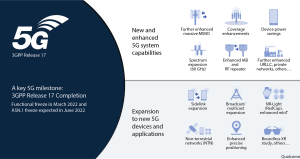CT Stories
3GPP declares the official completion of 5G NR Release 17

While it will take another three months to reach the next milestone, ASN.1 freeze for Release 17, work on 3GPP Release 18 is about to start.
The completion of 3GPP Release 17 marks an important 5G milestone. This includes a stage 3 freeze with ASN.1 targeted for June 2022. 3GPP Release 17 is the third major release of the 5G NR standard, wrapping up the first phase of 5G technology evolution across Releases 15, 16, and 17 in anticipation of 5G Advanced that begins in Release 18.
Release 17 brings further enhancements to the foundational aspects of the 5G system, pushing the technology boundaries on many fronts, including capacity, coverage, latency, power, mobility, and more. Here are a few key areas of improvement.
- Further enhanced massive MIMO. The Release 17 project focused on a few key areas of technology enhancements, including enhancements to multi-TRP (transmission and reception points) and multi-beam operations as well as improvements in SRS (sounding reference signals) triggering/switching and CSI (channel state information) measurement/reporting.
- Coverage enhancements. Targeting diverse deployments in sub-7 GHz, mmWave, and non-terrestrial networks, Release 17 introduced various enhancements to the uplink control and data channel design, such as increased repetitions for improved reliability and joint channel estimation across multiple transmissions and frequency hopping.
- Device power savings. To further extend battery life for mobile devices, Release 17 is bringing power-saving enhancements for both idle/inactive and connected operation modes. For example, it supports new techniques to reduce unnecessary device paging receptions, relaxation of device measurement for radio link, and more.
- Spectrum expansion. An important Release 17 project is to scale the existing 5G NR design to expand mmWave spectrum range from 24.25 to 52.6 GHz up to 71 GHz, also known as FR2-2 band in 3GPP. It includes the support for the global 60 GHz unlicensed band, which can open doors to new use cases and deployments.
- Enhanced IAB and simple repeaters. For more efficient 5G deployments, especially with mmWave, Release 17 enhanced IAB (integrated access/backhaul) to support simultaneous Tx and Rx (i.e., spatially separated full duplex), and introduced a simple repeater (i.e., amplify and forward relay), a new cost-efficient infrastructure option to expand coverage in FDD and TDD networks.
- Further enhanced URLLC, private networks, and more. Release 17 continues to drive better support for stringent applications (e.g., IIoT), with new enhancements to URLLC (ultra-reliable, low-latency communication), such as improved physical layer feedback, compatibility for unlicensed spectrum, intra-device multiplexing and prioritization, and more.

Release 17 takes another step toward the 5G vision of connecting virtually everything around us. A few key Release 17 projects that focus on delivering system optimizations for a broad range of devices and applications are:
- Reduced capability (RedCap or NR-Light) devices. To efficiently support lower complexity IoT devices (e.g., sensors, wearables, video cameras), Release 17 scales down wideband 5G NR design (i.e., 100 MHz bandwidth) to 20 MHz/100 MHz in sub-7/mmWave. It also reduces the number of receive antennas required at the device for regular 5G NR from four in most of the new sub-7 bands (i.e., n77/n78/n79, n41, etc.) to one or two in NR-Light. This project also enables further energy savings and coexistence with other 5G NR devices.
- Non-terrestrial networks (NTN). Following the Release 16 study, Release 17 introduced 5G NR support for satellite communications. It includes two distinct projects, one focusing on satellite backhaul communications for CPEs and direct low data rate services for handhelds, and a second project adapting eMTC/NB-IoT operation to satellite communications.
- Sidelink expansion. Building on the 5G PC5 design from C-V2X (cellular vehicle-to-everything) of Release 16, Release 17 brings a slew of new and enhanced sidelink capabilities, such as optimized resource allocation, power savings, and new frequency band support. It also expands sidelink to new use cases, such as public safety, IoT, and others by way of introducing sidelink relaying operation.
- Enhanced precise positioning. Release 17 further improves 5G positioning to meet more stringent use case requirements, such as centimeter-level accuracy. Additional enhancements are also part of the project, including positioning latency reduction, improved positioning efficiency for increased capacity, and better GNSS-assisted positioning performance.
- Broadcast/multicast expansion. Release 17 project scope includes standalone broadcast enhancements and mixed-mode multicast support. For instance, introducing the support of 6/7/8 MHz carrier bandwidths for standalone broadcast, and defining multicast operations for 5G NR with simultaneous/dynamic switching between broadcast and unicast transmissions.
- Boundless XR (extended reality). The metaverse is an ever-present spatial internet complete with personalized digital experiences that span the physical and virtual worlds. The Release 17 project on XR focused on studying and characterizing various types of XR traffic (AR, VR, cloud gaming). The study defines requirements and evaluation methodology for the identified XR traffic types, and provides performance evaluations, used toward the identification of areas of improvement for a future Release 18 project.
In addition to the main Release 17 projects, outlined above, there are many smaller 5G system enhancement projects, including improvements to multi-radio dual connectivity, multi-SIM support, higher-order modulation, small data transmission, quality of experience, data collection, RAN slicing, and more.

There will be the normal follow-on work that also occurred for R15 and R16, including the completion of a limited number of items granted extensions for an additional quarter, and the publication of the exact coding of low-level functions (ASN.1) work in June. R17 completion marks the conclusion of the first phase of 5G technology evolution, which started in R15.
While enhancing various aspects of the 5G system on many fronts, R17 lays the foundation for R18, the inaugural release for 5G Advanced that will include new innovations delivering the 5G vision.
While it will take another three months to reach the next milestone, ASN.1 freeze (translation: protocol freeze enabling implementations), for Release 17, work on 3GPP Release 18 is about to start. Release 18 is the inaugural standard release for 5G Advanced that will set off a new wave of wireless innovations and is expected to deliver on the 5G vision. At the same time, the 5G ecosystem is rapidly proliferating 5G networks globally and starting to commercialize Release 16 features, with Release 17 following in the near future.













You must be logged in to post a comment Login